Please Take Note: This is a review of the final game, but it might change slightly based on the success of the Kickstarter campaign. The game is being reviewed on the components and the rules provided with the understanding that “what you see is not what you might get” when the game is published. If you like what you read and want to learn more, we encourage you to visit the game publisher’s website or visit the Kickstarter campaign. Now that we have all that disclaimer junk out of the way, on with the review.
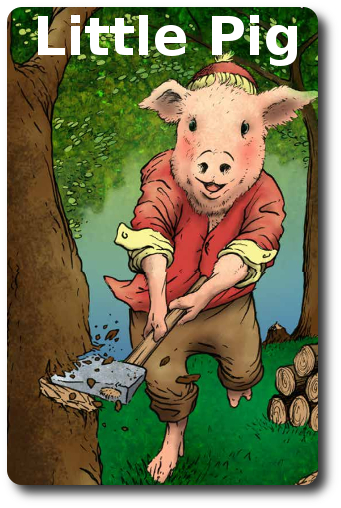
The Basics:
- For ages 8 and up (publisher suggests 13+)
- For 2 to 3 players
- Approximately 30 minutes to complete
Geek Skills:
- Counting & Math
- Logical & Critical Decision Making
- Reading
- Strategy & Tactics
- Hand/Resource Management
- Bluffing and Misdirection
Learning Curve:
- Child – Easy
- Adult – Easy
Theme & Narrative:
- To be top Pig, you have to throw some mud
Endorsements:
- Gamer Geek approved!
- Parent Geek approved!
- Child Geek approved!
Overview
When it came time for the 3 Little Pigs to leave their mother and make their own way in the world, they parted ways amiably. The casual observer would note nothing more than 3 brothers bidding each other a fond farewell. But the heart of each brother was bent on outdoing the others. These little piggies are ambitious and they’ll let none get in their way.
Little Pig, designed by Tim Eisner and to be published by Weird City Games, will reportedly be comprised of 1 game board, 3 Player boards, 36 wooden House sections (12 Straw, 12 Wood, 12 Brick; representing the floor, walls, and roof of houses), 36 Single Resource tokens (15 Straw, 12 Wood, 9 Brick), 12 Multi-Resource tokens (4 Straw, 4 Wood, 4 Brick), 20 Guess cards, 9 Gather cards, 9 Friend cards, 3 Pig tokens (1 per player), 1 Starting Player token, and e Wolf tokens. As this is a review of a prepublished game, I cannot comment on the game component quality. The illustrations by Ryan Swisher provide theme and narrative, using images one would find in old nursery rhyme or fairy tale books. There is also a subtle darkness just underneath the otherwise bright imagery that one has difficulty putting their finger on, but is nevertheless there. As is the case for most fairy tales…
Once Upon A Time
To set up the game, first place the game board in the middle of the playing area and give each player 1 Player board. The Player boards should be placed in front of the player.
Second, have each player select a Pig token and take the 3 Gather cards that match the token’s color. Any tokens, Gather cards, and Player boards not used should be placed back in the game box.
Third, place the Single and Multi-Resource tokens into a pile and the wooden House sections into another pile off to one side of the game board. These are the supply piles. Place the 3 Wolf tokens by the supply piles.
Fourth, place 5 “Straw” Resource tokens on the “Field” location on the game board, 4 “Wood” Resource tokens on the “Woods” location, and 3 “Brick” Resource tokens on the “Brickyard” location. This seeds the game board with the initial resources to be gathered.

Shuffle the Guess and Friend cards into separate decks and place each face-down next to the game board. Leave room for two discard piles.
That’s it for game set up. Determine who will go first and give them the Starting Player token.
By the Hair of My Chiny-Chin-Chin
Little Pig is played in rounds, phases, and turns. A typical game round is summarized here.
Phase 1: Gather Resources
Simultaneously, players will select 1 Gather card from their hand and place it face-down in front of them, alerting the rest of the players that they have made their decision. The 3 Gather cards depict the 3 major locations on the game board. Specifically, the “Field” where straw can be collected, the “Woods” where wood can be cut, and the “Brickyard” where bricks can be gathered in abundance. The player should play the Gather card that matches the location that holds the resource they need.
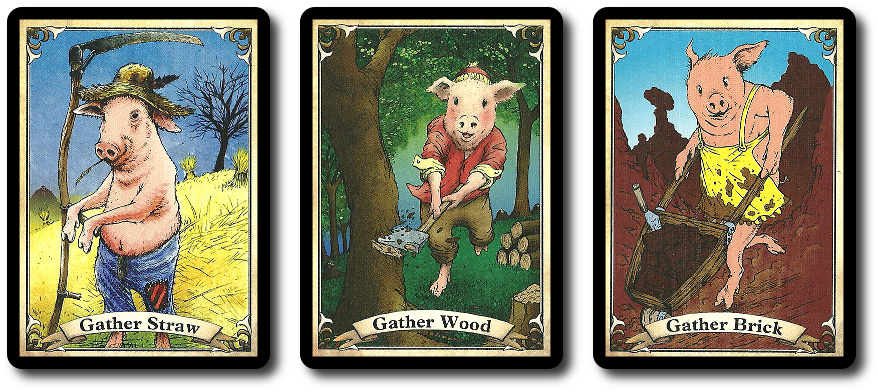
As the game progresses, a player might collect a Guess card. While playing the Gather card, a player can also place 1 Guess card face-down. The Guess card details a specific condition. If that condition is met, then the player receives a bonus. The goal of the Guess card is to anticipate what opponents will be doing during the round before the round even begins. A player who pays attention can deduce an opponent’s move to a surprisingly high level of accuracy, but not always. The player loses nothing but their Guess card if they guess incorrectly.
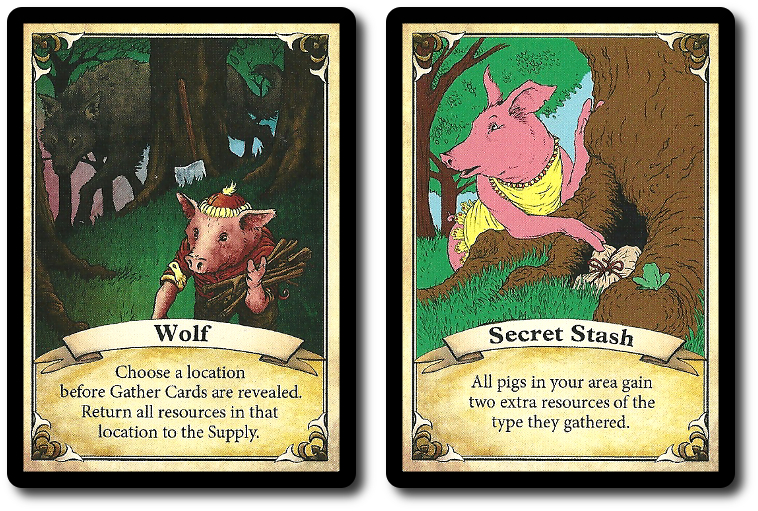
After all players have played their cards, the Starting Player asks the table, “Are there any wolves today?”. Any player who played a “Wolf” Guess card now reveals it. The “Wolf” Guess card plays differently than the other Guess cards. Instead of guessing what opponents might or might not do, the Wolf card gives the player the ability to “block” a location on the game board. A Wolf token is taken, placed in any location the player likes, and the “Wolf” Guess card is discarded. Any Resource tokens in that location are sent back to the supply pile.
After resolving any “Wolf” Guess cards, the Gather and Guess cards are revealed simultaneously. All players now move their Pig token to the game board location that matches their played Gather card. The Resource tokens are now collected (if any are on the location) and placed on the player’s Resource section of their Player board. If two or more players are in the same location, the Resource tokens are divided equally among all the players that have a Pig token in that location, rounding down if need be. Any Resources not collected or left over after sharing them among 2 or more players, remain on the game board for the next round.

Guess cards are now resolved beginning with the Starting player. These should all be Guess cards that are NOT wolves. If the player guessed correctly, they collect the reward. Then the Guess card is discarded, regardless if the player guessed correctly or not.
The phase ends with all players returning their Gather card back to their hand.
Phase 2: Market
The Market phase gives each player 2 actions. There are a number of different actions to select from, in any order, and the same action can be selected twice. This phase goes in turn order sequence beginning with the Starting Player since there are limited resources to be used.
Action: Build (Buy One House Piece)
The main objective of the game is to build Houses. A single House is comprised of 3 sections. These are “Floor”, “Walls”, and “Roof”. Additionally, a single House must be made of the same material. That is, a House cannot have a “Floor” of Straw, “Walls” of Wood, and a “Roof” of Bricks.
Houses must be built in a specific order. First “Floors, then “Walls”, and finally the “Roof”. Only 1 House of each Resource type can be built at the same time by a player. You cannot build 2 “Straw” Houses, but you can build 1 “Straw” House and 1 “Brick” House at the same time. Once a House of a specific Resource type is finish being built, a new House of the same Resource type can then be built.
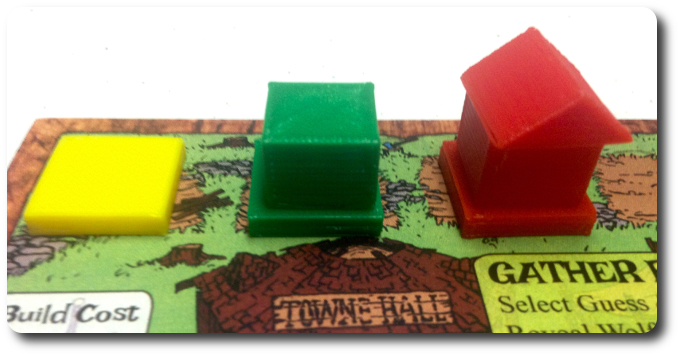
From left to right: “Straw” Floor, “Wood” Floor and Walls, and “Brick” Floor, Walls, and Roof (complete House)
There are only enough House pieces to build 4 of each House type and a player can only build a maximum of 4 Houses on their Player board (build spots are located at the top of the Player board). This means that House pieces are a limited resource and all players will be fighting to purchase them. The cost of each piece is listed here. The Resource token used as currency matches the House piece type to be purchased. Brick buys Brick Houses, for example. Building Houses also gives the player a bonus, making it even more worthwhile to build early and build often.
- Floor: 2 Resources
- Walls: 3 Resources + draw 1 Friend card and add it to the player’s hand or force an opponent to discard a Friend card
- Roof: 6 Resources + collect 1 of each Resource type and add it to the player’s personal Resource supply if they are the first to build a House type among all the players (for example, the first player to build a “Straw” House)
Action: Draw One Guess Card
For 1 action, the player can draw the top-most Guess card and add it to their hand. There is no limit to the number of cards a player can have in their hand.
Action: Gain One Resource Token
For 1 action, the player can select 1 Resource of any type (Straw, Wood, or Brick) from the supply pile and add it to their personal Resource supply pile. There is no limit to the number of Resource tokens a player can hold.
Phase 3: Clean Up
The final phase of the round organizes the playing area and makes it ready for the next round of game play. The Starting Player token is passed to the next player in turn order sequence and 5 “Straw” Resource tokens, 4 “Wood” Resource tokens, and 4 “Brick” Resource tokens are added to their matching location on the game board. Pig tokens are now returned and the Wolf tokens are placed by the supply piles.
With Friends Like These…
Friend cards represent the different characters found in other fairy tales that inhabit the same enchanting world as the player’s industrious swine. They are only earned when player builds a “Wall” House piece.
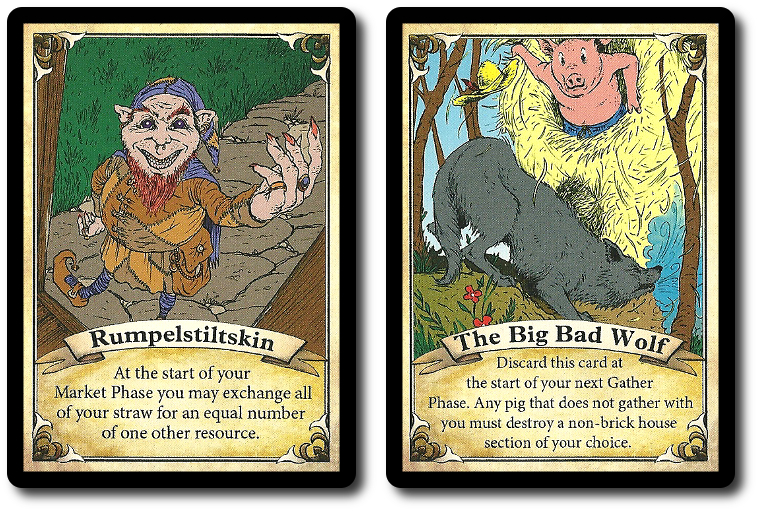
When a Friend card is drawn, it’s placed face-up next to the player’s Player board. A player can only have 1 Friend card in play at a time. If the player draws a new Friend card, the current Friend card in play is discarded and replaced or kept and the drawn Friend card is discarded.
Friend cards give the player extra abilities and bonuses when certain conditions are met, extra actions, and various other means to get ahead. It’s good to have friends in the game, but they are hated by opponents. As such, they often targeted and removed from the game.
And They All Lived Happily Ever Afterward
The game continues as described above until any of the following conditions are met.
- If only 1 player has 3 complete Houses by the end of the Market phase, that player has won the game.
- If more than 2 players have 3 complete Houses by the end of the Market phase, the player who built the sturdiest House wins the game. Brick is the sturdiest, followed by wood, and then straw (the weakest of the weak).
Ties are broken by total number of resources, with victory going to the player who has the most.
To learn more about Little Pig, visit the game publisher’s website or visit the Kickstarter campaign.
Final Word
The Child Geeks quickly understood the core concepts of the game and got to it. The only game aspect that tripped them up at first was the Guess cards. While the Child Geeks understood the intent of the cards and their use, we did not observe anything that would suggest deduction was being used. Rather, it appeared that the Child Geeks were just playing the cards because they could. This actually works, but is not very effective since the return on the card could be nothing if the guess was little more than a shot in the dark. But then something very interesting happened. The Child Geeks stopped guessing out of hand and started thinking things through. According to one Child Geek, “If you take a moment and look at what the other players are building, what resources they have, and what they did during the last round, you can make a really good guess what they will do this round.” Absolutely correct, which also meant that the Child Geeks had to start bluffing and changing things up. As one Child Geek put it, “If you are obvious about what you’ll be doing, you’re going to help others win.” The Child Geeks learned that Little Pig was a game that was played in the mind and on the table, resulting in moments of delight and disappointment. Through it all, they enjoyed themselves and gave Little Pig their full approval.

Older players were able to trick the Child Geeks and keep them guessing, but not forever
The Parent Geeks understood the importance of bluffing from the very start and used the Guess cards like experts. When a player guessed wrong, the table would laugh and cheer, but they did the same when a guess was correct. The collection and building aspects of game play became the least interesting steps in the game, with the primary focus and fun centering on the Meta game of players attempting to outwit each other. According to one Parent Geek, “I thought this was just a light weight gateway Euro game at first, but now I see it’s so much more.” Well, not a lot more. Little Pig could accurately be described as a light weight gateway Euro game, but there is more going on than just collecting resources and building houses. The Guess cards turned out to be the glue that held the game together. The Friend cards were enjoyed, but the Guess cards were always the focus of attention. As one Parent Geek put it, “Friends are nice, but outwitting your opponents is so much better.” When all the games were over, the Parent Geeks voted to approve Little Pig.
The Gamer Geeks were not fans of the game at first. They found it to be a good gateway game, but not something they would want to play. Then they started to use the Guess cards. This is when their games went from “ho-hum” to “hmmm”. Gamer Geeks like to really think their moves through and they have even more fun trying to think what their opponents’ will be doing. Little Pig doesn’t necessarily require a player to ponder an opponent’s move, but not doing so means not playing half the game. The Gamer Geeks started to see the Guess cards as a secondary move that could give them a real edge in the game or mean a tremendous set back. The Gamer Geeks also saw that the amount of effort spent attempting to deduce what an opponent might do was the same amount of effort the player had to spend to cover up their own motives. This really tickled the Gamer Geeks. According to one Gamer Geek, “This is a game that is played on two tables. The first is the one in front of all the players. It gives everyone information, but not everything. The second table is the one in every player’s mind where they attempt to figure out what everyone will be doing and how to keep everything hidden at the same time. I’m really enjoying it.”. Another Gamer Geek said, “I think this is a great game filler or to play over lunch kind of game. It has just the right amount of depth and challenge to keep me hooked and happy.” All the Gamer Geeks voted to approve Little Pig, finding it to be bigger than what they originally believed.
I am surprised that the Friend cards were not discussed by our groups in more depth. I found them to be very useful, but I can also see why the emphasis in the feedback primarily touched on the guessing aspect of the game play. It’s a lot of fun to attempt to outwit your opponent. So much fun, in fact, it kept out players coming back from more.
The most exciting phase in the game is the first. Here players must make important decisions that will impact the entire round. When the wolves are called and emerge, there is normally grumbling at the table from those who now have spoiled plans. When the Guess cards are revealed, grumbles are replaced by growls and by cheers. But not all cheers come from those who guess correctly and not all growls come from those who have been found out. It works both ways. It feels just as good to outwit an opponent as it does to deduce an opponent’s move. Likewise, the level of disappointment one feels from being transparent and from not guessing correctly is equal in measure.
A number of our players believed that Little Pig is a resource gathering game. I disagree somewhat. I think Little Pig is first and foremost a Deduction game that also happens to have a resource gathering included. I believe this to be true because collecting resources and building is very easy. Mindless, in fact, as there are always resources to gather and building is very straight forward. The real challenge is gathering resources and building while at the same time stopping opponents from doing the same. This takes deduction and subterfuge. Outwardly, a player must seem to be focused on one goal, but the real objective is kept in the player’s head as they attempt to outmaneuver their opponents.
I am very pleased with this little game. There is much more going on than the game’s title and components would suggest at first glance. It caught all of us by surprise and we were delighted by what we found. The game plays very well with Child Geeks and yet keeps even the most elitist Gamer Geek engaged. The limit of 3 players at maximum makes Little Pig difficult to play with a family, but the game itself is well worth playing. If you enjoy games where the objective is simple, but the path to reach it is anything but, then do sit down and play Little Pig. It’ll demand much of your mental power to be competitive, but it won’t be a pig about it.
This is a paid for review of the game’s final prototype. Although our time and focus was financially compensated, our words are our own. We’d need at least 10 million dollars before we started saying what other people wanted. Such is the statuesque and legendary integrity of Father Geek which cannot be bought except by those who own their own private islands and small countries.



